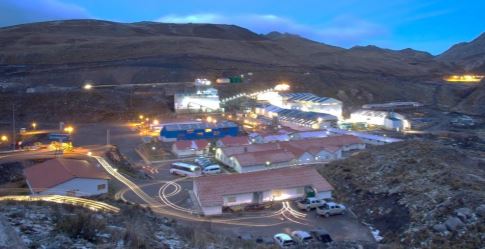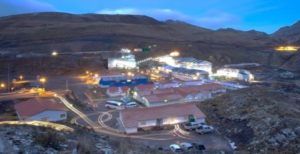Investment firm turns bullish on zinc, ups zinc stock price targets

Mining's Santander zinc mine in west-central Peru. Source: Trevali Mining Corp.
By Peter Kennedy

TD Securities is bullish on the outlook for the price of zinc and says Trevali Mining Corp. [TV-TSX, Lima; TREVF-OTCQX, 4T1-FSEt] remains its preferred way to gain exposure to the metal. The investment firm has upped its stock price targets for Trevali and a number of other players in the sector after increasing its zinc price forecast to US $1.76 this year from a previous target of US $1.65 a pound. That’s up from US $1.56 a pound on February 7, 2018.
TD has also revised its forecasts for the next two years, pushing its 2019 estimate to US $1.75 a pound and 2020 estimate to US $1.50 a pound. That’s up from the previous forecast of US $1.45 and US $1.30 respectively.
Zinc is primarily used for galvanizing steel to protect against weather and corrosion. Zinc can also improve crop yields and crop quality which provides health benefits to regions without zinc in the soil. The price of the metal has been on a steady climb since Swiss metals trading giant Glencore AG announced that it was shutting down 500,000 tonnes of mine production. That was back in October 2015, when zinc was trading at around 65 cents a pound. Prices were also driven higher by the closure of a number of large zinc mining operations in Ireland and Australia.
While TD expects mine supply to improve, it says supply will be mostly H2/18 weighted and is unlikely to affect refined metal supply until the first half of 2019.
“We expect that total zinc stocks will remain very low at 32-33 days of consumption through 2020 (the lowest since 1985), lending support to prices,” said TD Securities analyst Greg Barnes. “Low stocks and limited mine supply in 2018 could result in a sharp upward spike in prices,” he said.
Meanwhile, Barnes said Trevali Mining remains the investment firm’s top pick in the sector for zinc exposure. TD has raised its target price for Trevali to $2.50 from $2.25. That is largely because any US $0.10 change in the price of zinc affect’s Trevali’s 2018 earnings before tax, depreciation and amortization (EBITDA) by 9.5%. Trevali is producing zinc from operations in Peru, New Brunswick, Namibia and Burkina Faso. It’s Halfmile and Stratmat base metal deposits in New Brunswick are undergoing a preliminary economic assessment to review potential development.
TD has also raised its target price for a number of other companies in the zinc sector.
It has upped its target for Teck Resources Ltd. [TECK.B-TSX; TECK-NYSE] to $46 from $44. Based in Vancouver, Teck is a diversified mining giant with interests in copper, steelmaking coal, zinc and energy.
HudBay Minerals Inc. [HBM-TSX, NYSE] is raised to $17 from $16. HudBay has three operating mines in Manitoba’s Flin Flon Greenstone Belt of Manitoba and one operating mine in southern Peru. It is also developing the Rosemont polymetallic project in Arizona. Rosemont is expected to be one of the largest copper mines in the United States, accounting for approximately 10% of U.S. copper production.
Lundin Mining Corp. [LUN-TSX, LUM-OMX] has been increased to $10 from $9. Lundin is a diversified base metal mining company with operations in Chile, the United States, Portugal and Sweden, primarily producing copper, nickel and zinc. Lundin’s asset portfolio includes an indirect 24% stake in the Freeport Cobalt Oy business, which includes a cobalt refinery located in Kokkola, Finland.
Meanwhile, consulting group Wood Mackenzie has estimated that Chinese zinc supply rose 3.6% in 2017. During previous periods of elevated zinc prices, Chinese zinc mine production climbed upwards of 12-15% on a year over year basis. Wood Mackenzie attributed the difference between 2017 and previous years to the lower availability of both domestic and imported concentrate. It said this is constricting Chinese refined zinc production. In 2017, refined zinc production in China was down 0.7% year over year, despite a sharp spike in production in the fourth quarter of 2017.
“Weaker domestic zinc production is leading to higher imports of refined zinc, which totalled 676,000 tonnes in 2017, marking a plus 59% year over year increase, and a record high,” Wood Mackenzie said according to the TD report. That compares to the previous high of 670,000 tonnes in 2009.
TD went on to note in its report that zinc inventories are low and getting lower. Zinc fundamentals remain supportive with global exchange stocks at 10 year lows (equivalent to just six days of consumption) and the forward price curve not in backwardation through mid-2019, suggesting that the market expects supply to remain tight.
Also, treatment charges remain near record lows. Spot Chinese zinc treatment charges for January have been quoted at US$22.50 per tonne, up from $15.00 a tonne in December. But charges remain very low by historical standards. In 2015, the average spot treatment charge was US$201 per tonne. In 2017, the benchmark treatment charge was US $172 per tonne. TD notes that negotiations on 2018 treatment charges are just starting, with miners expecting to retain zero price participation over a lower treatment charge, possibly in the US $150 to US $160 per tonne range or a decrease of 10% year over year.
